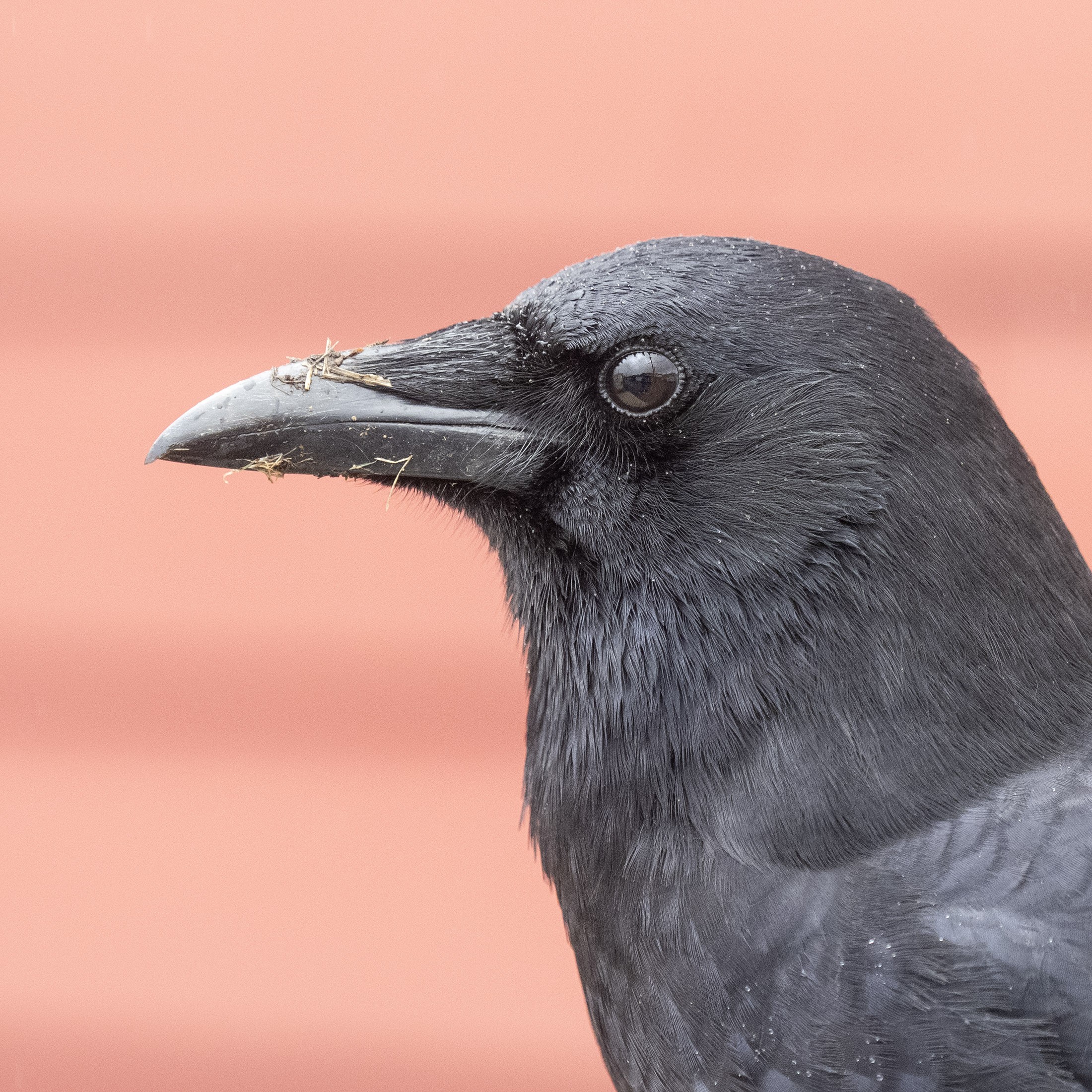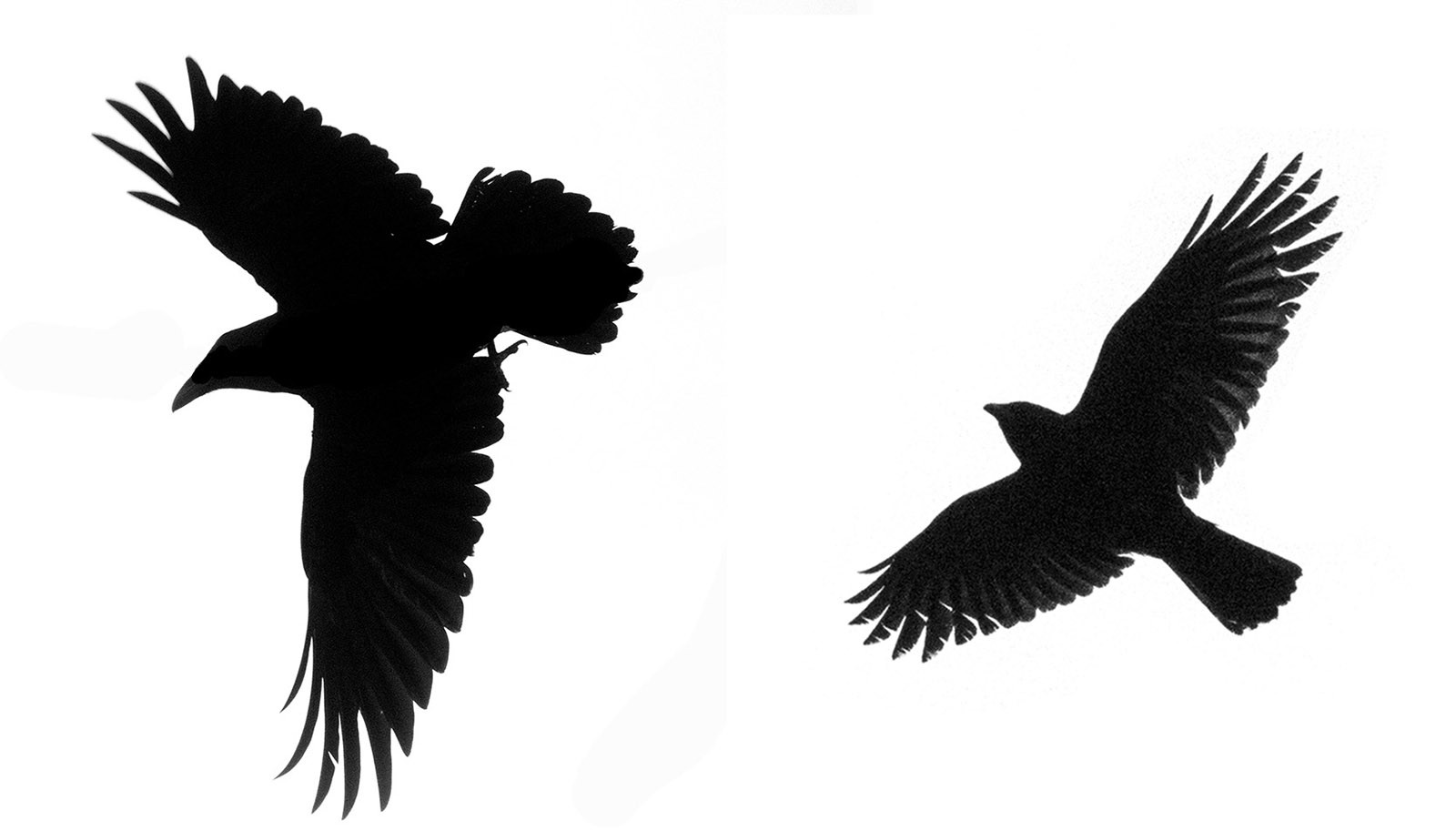How Big Are Ravens Compared To Crows? The answer lies in understanding their physical attributes and behaviors, a comparison expertly dissected by COMPARE.EDU.VN. This detailed analysis provides clarity for bird enthusiasts and helps you distinguish between these often-mistaken corvids. Delve into the nuances of raven vs. crow, and explore the size difference and physical traits that set them apart, enhancing your bird identification skills.
1. Introduction: Raven vs. Crow – Unveiling the Size Disparity
Ravens and crows, both belonging to the corvid family, often get mistaken for one another. While they share a similar black plumage, significant differences exist, especially in their size. Understanding how big are ravens compared to crows is crucial for accurate identification. COMPARE.EDU.VN offers a comprehensive comparison, revealing these size variations alongside other distinguishing features. This guide will help you appreciate the unique characteristics of each bird, including their raven size, crow size and overall raven crow comparison.
2. Decoding the Size: How Big Are Ravens Compared To Crows?
Size is a key differentiator between ravens and crows. Ravens are noticeably larger, often described as the size of a hawk, while crows are smaller, closer to the size of a pigeon. Let’s delve into the specifics:
2.1. Raven Dimensions: A Giant Among Corvids
Ravens typically measure between 24 to 27 inches (61 to 69 cm) in length, with a wingspan ranging from 45 to 47 inches (114 to 120 cm). Their weight usually falls between 2 to 3 pounds (0.9 to 1.4 kg). This larger size contributes to their more imposing appearance, setting them apart from their crow cousins.
2.2. Crow Proportions: Smaller and Sleeker
In contrast, crows are smaller, averaging 17 to 21 inches (43 to 53 cm) in length and boasting a wingspan of 33 to 39 inches (84 to 99 cm). Their weight is also lighter, generally ranging from 11 to 20 ounces (0.3 to 0.6 kg). These dimensions give crows a more compact and agile appearance compared to the robust raven.
2.3. Visual Size Chart: Raven and Crow Size Comparison
| Feature | Raven | Crow |
|---|---|---|
| Length | 24-27 inches (61-69 cm) | 17-21 inches (43-53 cm) |
| Wingspan | 45-47 inches (114-120 cm) | 33-39 inches (84-99 cm) |
| Weight | 2-3 pounds (0.9-1.4 kg) | 11-20 ounces (0.3-0.6 kg) |


This visual aid, curated by COMPARE.EDU.VN, provides a quick reference for understanding the size differences between these birds, addressing the key question, “how big are ravens compared to crows?”
3. Physical Attributes Beyond Size: Identifying Ravens and Crows
While size is a primary indicator, several other physical attributes distinguish ravens from crows. These include their beak shape, throat feathers, and tail structure.
3.1. Beak Morphology: Differentiating Features
Ravens possess a larger, heavier beak with a noticeable curve, ideal for tearing meat and consuming larger prey. This robust beak is a prominent feature, contributing to their formidable appearance.
Crows, on the other hand, have a smaller, more slender beak suited for foraging and consuming grains and insects. The crow beak is more streamlined, reflecting their different feeding habits.
3.2. Throat Feathers: A Raven’s Luxurious Cravat
Ravens are known for their shaggy throat feathers, which create a “beard-like” appearance. These feathers add to their distinctive look and are often visible when the bird vocalizes.
3.3. Tail Shape: In Flight Identification
The tail shape is another reliable way to distinguish between ravens and crows, especially when observing them in flight. Ravens have a wedge-shaped or diamond-shaped tail, while crows have a fan-shaped or squared-off tail. This difference is noticeable when the birds are soaring or gliding.
4. Behavioral Traits: Unveiling the Differences in Demeanor
Beyond physical attributes, behavioral traits also play a crucial role in distinguishing ravens from crows. These include their flight patterns, vocalizations, and social behaviors.
4.1. Flight Patterns: Soaring vs. Flapping
Ravens are known for their soaring flight, often seen gliding effortlessly on air currents. This behavior is facilitated by their larger wingspan, allowing them to cover long distances with minimal effort.
Crows, in contrast, tend to flap their wings more frequently, resulting in a more direct and less graceful flight. While they can glide, they generally rely more on flapping for propulsion.
4.2. Vocalizations: Caw vs. Croak
One of the most distinct differences between ravens and crows lies in their vocalizations. Crows are known for their classic “caw-caw” sound, which is familiar to many.
Ravens, however, produce a deeper, more resonant “croak” or “guttural” sound. They also have a wider range of vocalizations, including clicks, rattles, and even mimicry.
4.3. Social Behavior: Solitary vs. Gregarious
Ravens tend to be more solitary or live in pairs, often defending their territory aggressively. They are less likely to form large flocks, except when scavenging at abundant food sources.
Crows, on the other hand, are highly social birds, often forming large flocks or “murders,” especially during the non-breeding season. These flocks provide safety in numbers and facilitate information sharing.
5. Habitat and Distribution: Where Do Ravens and Crows Reside?
Understanding the habitat and distribution of ravens and crows can also aid in identification. While both species can coexist in certain areas, they generally prefer different environments.
5.1. Raven Habitats: Wilderness and Remote Areas
Ravens are typically found in wilderness areas, including forests, mountains, and deserts. They prefer remote locations with ample space and resources, avoiding densely populated urban areas.
5.2. Crow Habitats: Urban and Agricultural Landscapes
Crows are more adaptable to human presence and thrive in urban and agricultural landscapes. They can be found in parks, fields, and even city centers, often scavenging for food in human-dominated environments.
6. Intelligence and Problem-Solving: Cognitive Prowess
Both ravens and crows are renowned for their intelligence and problem-solving abilities. However, there are subtle differences in how they exhibit these cognitive skills.
6.1. Raven Intellect: Complex Problem Solvers
Ravens are known for their complex problem-solving skills, often demonstrating an understanding of cause and effect. They have been observed using tools, planning for the future, and even deceiving other ravens.
6.2. Crow Intellect: Social Learners and Adaptable Thinkers
Crows excel at social learning, observing and imitating the behaviors of other crows. They are also highly adaptable thinkers, able to modify their strategies based on changing circumstances.
7. Raven and Crow: Folklore and Symbolism
Across cultures, ravens and crows have been imbued with rich symbolism and folklore, reflecting their perceived intelligence, adaptability, and mysterious nature.
7.1. Raven Symbolism: Mysticism and Wisdom
Ravens often symbolize mysticism, prophecy, and wisdom. In Norse mythology, Odin had two ravens, Huginn (thought) and Muninn (memory), who flew around the world and reported back to him. In some Native American cultures, the raven is seen as a trickster figure or a creator.
7.2. Crow Symbolism: Intelligence and Omen
Crows are often associated with intelligence, adaptability, and sometimes, as omens of change or misfortune. In some cultures, they are seen as messengers between worlds, while in others, they are simply admired for their cunning and resourcefulness.
8. Conservation Status: Are Ravens and Crows Threatened?
Understanding the conservation status of ravens and crows is crucial for ensuring their continued survival and ecological roles.
8.1. Raven Conservation: Least Concern
The common raven (Corvus corax) is currently listed as “Least Concern” by the International Union for Conservation of Nature (IUCN). This means that the species is widespread and abundant, with no immediate threats to its overall population.
8.2. Crow Conservation: Generally Stable
Most crow species, including the American crow (Corvus brachyrhynchos), are also considered to be of “Least Concern.” While some local populations may face challenges due to habitat loss or persecution, the overall populations are generally stable.
9. Engaging Activities: Test Your Raven and Crow Knowledge
To solidify your understanding of raven and crow differences, engage in these activities:
9.1. Birdwatching Challenge: Identify Local Corvids
Go birdwatching in your local area and try to identify ravens and crows based on the characteristics discussed in this guide. Pay attention to their size, shape, vocalizations, and behavior.
9.2. Quiz: Raven vs. Crow Trivia
Test your knowledge with a fun quiz. Questions could include:
- What is the average size difference between ravens and crows?
- Which bird has shaggy throat feathers?
- Which bird is more likely to be found in urban areas?
10. COMPARE.EDU.VN: Your Comprehensive Guide to Bird Identification
COMPARE.EDU.VN is dedicated to providing comprehensive and accurate information to help you distinguish between various species. Our detailed guides cover everything from physical attributes to behavioral traits, ensuring you have the knowledge you need to confidently identify different birds.
10.1. Discover More Bird Comparisons
Explore our website for more bird comparisons, including:
- Hawks vs. Eagles
- Sparrows vs. Finches
- Swallows vs. Swifts
10.2. Expert Insights and Analysis
Our team of experts provides in-depth analysis and insights, ensuring you receive the most accurate and up-to-date information. We are committed to enhancing your understanding and appreciation of the natural world.
11. FAQs: Clarifying Raven and Crow Questions
11.1. How can I quickly identify a raven in flight?
Look for a larger bird with a wedge-shaped tail and soaring flight pattern.
11.2. Do ravens and crows interbreed?
While they belong to the same family, interbreeding is rare due to genetic differences and behavioral isolation.
11.3. Are ravens more intelligent than crows?
Both are highly intelligent, but ravens are known for complex problem-solving, while crows excel at social learning.
11.4. What is the typical lifespan of a raven?
Ravens can live up to 10-15 years in the wild, and even longer in captivity.
11.5. What is the typical lifespan of a crow?
Crows typically live for 4-7 years in the wild.
11.6. What do ravens eat?
Ravens are omnivores, eating carrion, insects, grains, and fruits.
11.7. What do crows eat?
Crows are also omnivores, with a diet including insects, seeds, grains, and small animals.
11.8. Are ravens protected by law?
Yes, ravens are protected under the Migratory Bird Treaty Act in the United States.
11.9. Are crows protected by law?
Yes, crows are also protected under the Migratory Bird Treaty Act in the United States, although there are exceptions for managing agricultural damage.
11.10. How can I attract ravens to my yard?
Ravens are less likely to visit residential yards, but providing a water source and leaving out scraps of meat may attract them.
12. Conclusion: Mastering Raven and Crow Identification
Understanding how big are ravens compared to crows is a fundamental step in distinguishing these fascinating birds. By considering their size, physical attributes, behavioral traits, and habitat preferences, you can confidently identify ravens and crows in the field. COMPARE.EDU.VN provides the resources and insights you need to enhance your bird identification skills and deepen your appreciation for these remarkable corvids.
Ready to put your knowledge to the test? Visit COMPARE.EDU.VN for more detailed comparisons and expert insights. Don’t just wonder, know the difference! Discover the fascinating world of birds and make informed decisions with COMPARE.EDU.VN.
For further inquiries or assistance, contact us at:
Address: 333 Comparison Plaza, Choice City, CA 90210, United States
WhatsApp: +1 (626) 555-9090
Website: compare.edu.vn